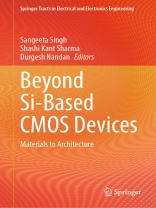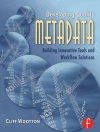This book focuses on summarizing recent research trends for new beyond-CMOS and beyond-silicon devices, circuits, and architectures for computing. It reports the recent achievements in this field from leading research trends around the globe, specifically focusing on nanoscale beyond silicon materials and devices, functional nanomaterials, nanoscale devices, beyond-CMOS devices materials, and their opportunities and challenges. The book is devoted to the fast-evolving field of modern material science and nanoelectronics, particularly to the physics and technology of functional nanomaterials and devices.
Inhoudsopgave
Beyond Si Based CMOS Devices: Needs, Opportunities and Challenges.- Nanowire Based Si CMOS Devices.- Carbon Nanotube FETS: An Alternative For Beyond Si Devices.- Graphene Based Devices for Beyond CMOS Applications.- Other Potential 2-D Materials for CMOS Applications.- Heterogenous Integration of 2D Materials with Silicon-Complementary Metal Oxide Semiconductor (Si-CMOS) Devices.- TFET: From Material to Device Perspective.- Negative Capacitance Field Effect Transistor (NCFET): Strong Beyond CMOS Device.- Nanoelectromechanical Switches: As a Steep switching Device.- The Device-Circuit Co-Design Perspective on Phase-Transition and Hybrid Phase-Transition (Hyper-) FETs, Phase-FETs, and MOSFET.- Feedback Field-Effect Transistors/ Zero Subthreshold Swing and Zero Impact Ionization FET.- Resistive-Gate Field-Effect Transistor: A Potential Steep-Slope Device.- Spin Field-Effect Transistor: For Steep Switching Behaviour.
Over de auteur
Dr. Sangeeta Singh is an assistant professor at the Department of Electronics and Communication Engineering, NIT Patna, India. She has been recognized as an eminent scholar in the field of Electronics & Computer Engineering. She has published many research papers in reputed national/international journals and conferences. Along with this, she has actively participated in various technical course workshops, seminars, etc. at the NITs. She has been recognized as an eminent scholar in the field of Electronics & Computer Engineering. She has actively participated in various technical course workshops and seminars at the NITs. She has edited three books (titles and ISBN). She is a senior member of IEEE, IEEE EDS Society, IET, etc. She has chaired sessions, served on TPCs, and served as a reviewer for over 10 reputable national and international conference proceedings. She holds three Indian patents as an inventor or co-inventor.
Dr. Shashi Kant Sharma is working as Assistant Professor in Department of Electronics & Communication Engineering at Indian Institute of Information Technology, Ranchi, India (An Institute of National Importance Under MHRD, Govt. of India). He is in the Board of Governors of IIIT Ranchi and is also serving as Associate Dean: Faculty Affairs, Infrastructure and Campus Administration. He holds a Ph D from Malaviya National Institute of Technology, Jaipur. Dr. Sharma has published more than 40 papers in many leading international journals, books and international conferences. He has awarded 3 Ph.Ds and also serves as reviewer in several peer reviewed journals and conferences. His research interests include modelling, simulation and fabrication of emerging nanoscale devices and circuits.
Dr. Durgesh Nandan is working as an Associate Dean (Research) and Associate Faculty in the School of CS & AI at SR University, Warangal, India. He received the B.Tech. degree in ECE from the BCE, Bhopal, India, in 2006; the M.Tech. degree with honors in Microelectronics and VLSI from TIT Bhopal, India, in 2013; and the Ph.D. degree from the Jaypee University of Engineering and Technology, India, in 2018. He is a session chair, TPC, and reviewer for more than 100 reputed national and international conference proceedings. He is the author or co-author of more than 150 research papers, which were published in SCI, Scopus, and peer-reviewed international journals and conference proceedings. His research interests extend to several areas, like computer arithmetic, VLSI architecture for signal processing applications, speech processing, the hardware architecture of real-time big data and AI applications, and the Internet of Things.












